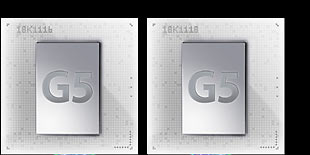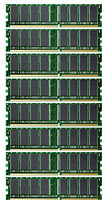 |
  |
| The
PowerPC G5 marks the beginning of 64-bit computing on the desktop. This
means unprecedented performance and capacity as well as a smooth
transition only Apple could deliver. And in fact, the forward-looking
G5 architecture scales to meet memory requirements for the next twenty
years, even if they double every year. Mindboggling memory  Even elephants would be
hard-pressed to keep track of as much data as the PowerPC G5. With 8GB
of main memory, the PowerMac G5 can hold a gigantic 3D model, a complex
scientific simulation or a sequence of HD video entirely in RAM —
drastically reducing the time to access, modify and render such data.
That’s because it’s 60,000 times faster to access RAM than your hard
drive, and you can stream 40 times more data between RAM and the
processor. Theoretically, the G5 could address up to 18 billion billion
bytes of virtual memory. Or 18 exabytes for short. But in practice, the
PowerPC G5 has 42 bits of address space for memory, which means it
supports just 242 or 4 terabytes of system memory. You can’t
put that much RAM in a desktop computer — yet — but it sets the stage
for untold computational feats. Even elephants would be
hard-pressed to keep track of as much data as the PowerPC G5. With 8GB
of main memory, the PowerMac G5 can hold a gigantic 3D model, a complex
scientific simulation or a sequence of HD video entirely in RAM —
drastically reducing the time to access, modify and render such data.
That’s because it’s 60,000 times faster to access RAM than your hard
drive, and you can stream 40 times more data between RAM and the
processor. Theoretically, the G5 could address up to 18 billion billion
bytes of virtual memory. Or 18 exabytes for short. But in practice, the
PowerPC G5 has 42 bits of address space for memory, which means it
supports just 242 or 4 terabytes of system memory. You can’t
put that much RAM in a desktop computer — yet — but it sets the stage
for untold computational feats.
Logical thinking The G5’s execution core is derived from IBM’s POWER4 processor: two double-precision floating-point units, advanced branch prediction logic and a high-bandwidth frontside bus. To that superscalar, superpipelined execution core, Apple and IBM added the Velocity Engine to the design, so software that optimizes vector math routines will run on the Power Mac G5 without needing new versions. |
Fastest bus in
the west The G5 features a scalable design that enables it to run at clock speeds up to 2GHz. This represents a 600MHz jump, the largest in PowerPC history, over the fastest G4 processor at 1.4GHz. But all the megahertz in the world wouldn’t mean squat if the G5 were stuck talking to the rest of the machine at the 167Mhz bus speed of the Power Mac G4. That’s why the G5 features two unidirectional 32-bit data paths: one traveling into the processor and one traveling from the processor, unlike previous designs. Its frontside bus works at speeds up to 1GHz for an astounding 8 GBps of total bandwidth. That makes it 200MHz faster than even the latest Intel 875 chipset, which sputters out at 800MHz. Dual independent buses for dualies Both Mac OS X and the G5 fully support symmetric multiprocessing, which lets multiple applications run independently on different processors or a single multithreaded application perform multiple tasks simultaneously. To ensure maximum efficiency on dual 2.0GHz G5 systems, each processor has its own dedicated 1GHz frontside bus. The resulting bandwidth of 16 GBps offers more than twice the 6.4-GBps maximum throughput of Pentium 4-based systems. In addition to providing fast access to main memory, this high-performance frontside bus architecture lets each G5 discover and access data in the other processor’s cache. No progress penalty  The PowerPC architecture was designed from the get-go
for both 32- and 64-bit processing. That means the Power Mac G5 can run
everything you run today, with no performance penalty. Contrast that
with the competition, where switching to 64-bit computing will mean
costly expenditures for 64-bit software or running a 32-bit operating
system in a slow emulation mode. That’s right, current 32-bit Mac OS
programs — including Mac OS X itself, the Classic environment and
existing applications — run natively at processor speed, with no
interruptions to your workflow and no additional investment in
software. In fact, Mac OS X applications that take advantage of the
PowerPC G4 Velocity Engine will immediately run faster on the G5. Of
course, Mac OS X applications tuned for the G5 will run even faster. The PowerPC architecture was designed from the get-go
for both 32- and 64-bit processing. That means the Power Mac G5 can run
everything you run today, with no performance penalty. Contrast that
with the competition, where switching to 64-bit computing will mean
costly expenditures for 64-bit software or running a 32-bit operating
system in a slow emulation mode. That’s right, current 32-bit Mac OS
programs — including Mac OS X itself, the Classic environment and
existing applications — run natively at processor speed, with no
interruptions to your workflow and no additional investment in
software. In fact, Mac OS X applications that take advantage of the
PowerPC G4 Velocity Engine will immediately run faster on the G5. Of
course, Mac OS X applications tuned for the G5 will run even faster. |
| . | . | . |
| -- |
PowerMac G5
|
Juli. |
|
64-bit breakthrough
|
2003
|